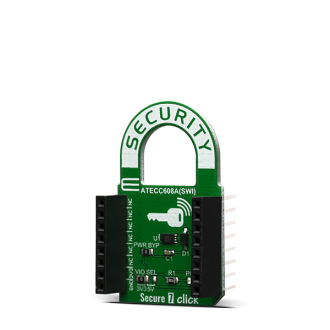
We strongly encourage users to use Package manager for sharing their code on Libstock website, because it boosts your efficiency and leaves the end user with no room for error. [more info]

Rating:
Author: MIKROE
Last Updated: 2022-04-15
Package Version: 1.0.0.0
mikroSDK Library: 1.0.0.0
Category: Encryption
Downloaded: 273 times
Not followed.
License: MIT license
Secure 7 click carries the ATECC608A cryptographic coprocessor with secure hardware-based key storage, from Microchip. The ATECC608A includes an EEPROM array which can be used for storage of up to 16 keys, certificates, miscellaneous read/write, read-only or secret data, consumption logging, and security configurations.
Do you want to subscribe in order to receive notifications regarding "Secure 7 click" changes.
Do you want to unsubscribe in order to stop receiving notifications regarding "Secure 7 click" changes.
Do you want to report abuse regarding "Secure 7 click".
| DOWNLOAD LINK | RELATED COMPILER | CONTAINS |
|---|---|---|
| 1650015480_secure_7_click_mikroc_arm.zip [1.29MB] | mikroC PRO for ARM |
|
| 1573573648_secure_7_click_mikroc_other.zip [1.23MB] |
|


Library Description
The library covers all the necessary functions to control Secure 7 click board.
Key functions:
void secure7_send_bytes ( uint8_t count, uint8_t *p_buf ) - Send bytes function.void secure7_send_wake_token() - Send wake token function.uint8_t secure7_receive_bytes ( uint8_t count, uint8_t *p_buf ) - Receive bytes function.Examples description
The application is composed of three sections :
void application_task ( )
{
if ( atcab_read_serial_number( &buffer_out[ 0 ] ) == ATCA_SUCCESS )
{
mikrobus_logWrite( " Serial number : ", _LOG_LINE );
secure7_output_hex( &buffer_out[ 0 ], 9 );
}
else
{
mikrobus_logWrite( " Reading serial number failed...", _LOG_LINE );
}
mikrobus_logWrite( "----------------------------------------", _LOG_LINE );
Delay_ms ( 1000 );
if ( atcab_info( &buffer_out[ 0 ] ) == ATCA_SUCCESS )
{
mikrobus_logWrite( " Device revision information : ", _LOG_LINE );
secure7_output_hex( &buffer_out[ 0 ], 4 );
}
else
{
mikrobus_logWrite( " Reading device revision information failed...", _LOG_LINE );
}
mikrobus_logWrite( "----------------------------------------", _LOG_LINE );
Delay_ms ( 1000 );
if ( atcab_read_config_zone( ATECC608A, &buffer_out[ 0 ] ) == ATCA_SUCCESS )
{
mikrobus_logWrite( " First 32 bytes of device configuration :",_LOG_LINE );
secure7_output_hex( &buffer_out[ 0 ], 32 );
}
else
{
mikrobus_logWrite( " Reading config zone failed...",_LOG_LINE );
}
mikrobus_logWrite( "----------------------------------------", _LOG_LINE );
Delay_ms( 10000 );
}
Additional Functions :
secure7_set_output - SWI directions set implementation - output.secure7_set_input - SWI directions set implementation - input.secure7_output_hex - Display output data in hex format.Other mikroE Libraries used in the example:
Additional notes and informations
Depending on the development board you are using, you may need USB UART click, USB UART 2 click or RS232 click to connect to your PC, for development systems with no UART to USB interface available on the board. The terminal available in all MikroElektronika compilers, or any other terminal application of your choice, can be used to read the message.